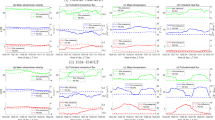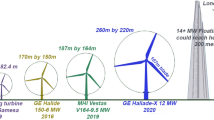Abstract
We present a comparative study of the conventional stationary wind speed model and a newly proposed non-stationary wind speed model using field measurements. The concept of, and the differences between, the two wind models are briefly reviewed. Wind data recorded by a field measurement system for wind turbulence parameters (FMS-WTP) of 1-year duration are analyzed using the two wind models. Comparisons were made between the wind characteristics obtained from the two models, including hourly mean wind speed, turbulence intensity, the wind spectrum, integral length scale, root coherence function and probability density function. The effects of wind types (monsoon or typhoon), statistical properties (stationary or non-stationary), and surface roughness (open-sea fetch or overland fetch) on wind characteristics are discussed. The comparative study demonstrates that the non-stationary wind model appears to be more appropriate than the conventional stationary wind speed model for characterizing turbulent winds of one-hour duration over complex terrain.
Similar content being viewed by others
References
Bendat JS, Persol AG (1986) Random data analysis and measurement procedure. 2nd edn, John Wiley & Sons, New York, pp 144–147
Engineering Science Data Unit (ESDU). (1986) Characteristics of atmospheric turbulence near the ground, Part III, ESDU Item 86010, 4 pp
Huang NE, Shen Z, Long SR, Wu MC, Shih HH, Zheng Q, Yen NC, Tung CC, Liu HH (1998) The empirical mode decomposition and the Hilbert spectrum for nonlinear and non-stationary time series analysis. Proc R Soc Lond A 454:903–995
Schroeder JL, Smith DA, Peterson RE (1998) Variation of turbulence intensities and integral scales during the passage of a hurricane. J Wind Eng Ind Aerodyn 77&78:65–72
Simiu E, Scanlan RH (1996) Wind effects on structures: fundamentals and applications to design. 3rd edn, Wiley, New York, 54 pp
Tamura Y, Shimada K, Hibi K (1993) Wind response of a tower (typhoon observation at the Nagasaki Huis Ten Bosch Domtoren). J Wind Eng Ind Aerodyn 50:309–318
Teunissen HW (1980) Structure of mean winds and turbulence in the planetary boundary layer over rural terrain. Boundary-layer Meteorol 19:187–221
Xu YL, Zhan S (2001) Field measurement of Di Wang Tower during Typhoon York. J Wind Eng Ind Aerodyn 89:73–93
Xu YL, Chen J (2004) Characterizing nonstationary wind speed using empirical mode decomposition. J Struct Eng ASCE 130(6):912–920
Author information
Authors and Affiliations
Corresponding author
Rights and permissions
About this article
Cite this article
Chen, J., Hui, M.C.H. & Xu, Y.L. A Comparative Study of Stationary and Non-stationary Wind Models Using Field Measurements. Boundary-Layer Meteorol 122, 105–121 (2007). https://doi.org/10.1007/s10546-006-9085-1
Received:
Accepted:
Published:
Issue Date:
DOI: https://doi.org/10.1007/s10546-006-9085-1




